Activity 17
Competition analysis
Porter’s five forces
Overview
Michael Porter (1980) originally developed the five-forces model as a way of evaluating the attractiveness (profit potential) of an industry. He described his analysis as being concerned with the ‘forces driving industry competition’.
This model can aid the category strategy-development process. Assessing all facets of potential supply competition provides a rounded view when deciding upon what action to take in order to gain a competitive advantage.
Elements
In any industry, whether it is domestic or international, or whether it produces a product or a service, the rules of competition are embodied in five competitive forces that Porter classified as follows:
- Threat of new entrants – This relates to the competitive pressures placed by new entrants to a market and the degree to which this can be prevented by barriers to entry (which are factors that new entrants to the market will need to overcome to be successful).
- Bargaining power of suppliers – Where demand exceeds supply, the supply base will have greater bargaining power over buyers, particularly if there are no alternative sources of supply. It is essential to reduce as much dependency and competitive pressure from suppliers as possible.
- Bargaining power of customers – Where supply exceeds demand from customers, or the demand is heavily consolidated, additional pressures will be placed upon the market. This will increase competition and reduce prices unless the customers’ bargaining power can be negated.
- Threat of substitutes – Alternative products and services increase competitive pressures on a market simply because they reduce the customers’ dependency and give them more opportunity to switch to alternatives.
- Rivalry within the market – Competition within the market will depend on just how saturated or dynamic the market is.
So what?
Lack of competition improves profit potential in a market. Category managers therefore need to understand how to develop supply-market opportunities for their categories in order to improve their overall leverage.
Correct application of this model should be at the lowest level of category hierarchy (i.e. at the granular, microindustry level); otherwise the output could be too ‘broad brush’ and thus potentially meaningless.
Category management application
- Provides an overview of supply and demand factors in operation and the impact on a category strategy
- Supports the development of supply-market analysis
- Highlights potential areas for market leverage
- Could stimulate market/supplier development strategies
Limitations
This model has been the subject of some critical comment, largely surrounding the static nature of the framework. Category management in comparison is a proactive, dynamic and ongoing process.
It has also been argued that category managers tend to ‘fit’ a strategy around Porter’s five forces in order to accommodate the output, whereas a more modern approach is to ‘stretch’ a strategy – that is, be more lateral and forward thinking – in order to circumnavigate the market supply and demand parameters.
Template
The following template can be used to analyse market forces and rivalry that might impact a category strategy:
- Template 17: Porter’s five forces
